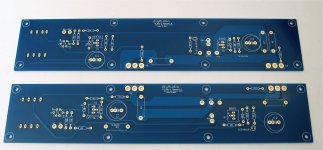Tannoy Legacy Arden
Specifications
Recommended Amplifier Power: 20-300 W.
Power handling: 150 W continuous, 600 W peak.
Sensitivity: 93 dB.
Impedance: 8 ohm.
Crossover Frequency: 1.1 kHz.
Enclosure: Triple distributed port.
Net weight: 41 kg (90 lb)
Specifications
Recommended Amplifier Power: 20-300 W.
Power handling: 150 W continuous, 600 W peak.
Sensitivity: 93 dB.
Impedance: 8 ohm.
Crossover Frequency: 1.1 kHz.
Enclosure: Triple distributed port.
Net weight: 41 kg (90 lb)
Attachments
got plenty of sensitivity and voltage swing (27V rms).
Where is the volume knob for most of your listening?
What's the source material?
Where is the volume knob for most of your listening?
What's the source material?
I think that many descriptions of the F6 talk about its clarity and musicality. Very strong (slamming) dynamics are probably not something that it is known for.Find that my F6 is detailed, however is not as dynamic as I had hoped. Could it be a mismatch with my Perreaux SM3 preamp? Or will the sound change after 100 hours or so? Have upped the bias from 575mv to 700mv.
I have seen the F6 described as a gentleman's amp. (Or, old mans amp!) It is very smooth.
hi, first off thanks so much for this build guide and discussion, been extremely helpful for building this amp as a first time project
I already have my power supply built/working, but was looking to mount it vertically to free up some case room - I bought a strongtie bracket that I saw suggested somewhere else here on diyaudio and when I was checking the sizing on it today against my transformer, is it a problem if the side of the transformer comes into contact with the side of the mounting bracket like this rather than being high enough to be floating? Should I try and see if I can fit a piece of rubber to protect the windings or is that not necessary?

I already have my power supply built/working, but was looking to mount it vertically to free up some case room - I bought a strongtie bracket that I saw suggested somewhere else here on diyaudio and when I was checking the sizing on it today against my transformer, is it a problem if the side of the transformer comes into contact with the side of the mounting bracket like this rather than being high enough to be floating? Should I try and see if I can fit a piece of rubber to protect the windings or is that not necessary?
rubber ring is always a must, from both sides of Donut
try also to find bigger L bracket , having bigger area for Donut support
try also to find bigger L bracket , having bigger area for Donut support
woops, apologies for being unclear, I meant the side of the xformer having contact with the bracket assuming that the regular mounting hardware was also present like this, I think you're probably right and this bracket may be too small either way but wasn't sure if this is hypothetically a problem, I don't think it causes a short but wasn't sure if it could hurt anything else

no electrical problem with side of bracket (bottom on pic) touching the Donut , but better to insert rubber in between too
as shown on pic, as long other side of Donut fixing screw is not electrically connected to case (or anything else), there is no short
as shown on pic, as long other side of Donut fixing screw is not electrically connected to case (or anything else), there is no short
I used a section of an old innertube to put between the side of the x-former and the foot of the bracket.
Adding my 2 cents to the discussion about the dynamics (or lack) of the F6 amp.
It's been my experience that the type and size of the power supply has a lot to do with the dynamics of the amp - for example, the original design called for a total capacitance of 45,000uF per rail (15mF, R-15mF, R+15mF per rail) and a standard block bridge fed from a single 300va torroidal transformer.
Many of us have gone dual mono, used fancy pants diode bridges (or the synchronous ones) then added really huge capacitors following the idea that bigger/more is better, just like the crazy sized caps often recommended for the Hiraga 30w amp.
Now some of these big caps are woefully "slow", as the saying goes, and this may create that 'laid back' or 'old man' sound of the amp - I say 'may' because the caps vary enormously - the old big ones like the Phillips, Roedesteins, CDE, etc fit this category and I don't often use any over 10,000uF for just that reason - the maximum size of the 4TTN (4 pole caps is 10,000uF for a good reason, according to the designer, Denis Morecroft. I doubt this will apply to all of the bigger sized caps, especially these days as they steadily develop better manufacturing techniques
As some people have found, regulator power supplies come as a mixed blessing, particularly the high gain, high feedback ones, and some produce a 'pretty ordinary' sound in these simple amps but others seem to function extremely well - the non-regulated Micro Audio SMPS function/sound very well on the F6 for example, and that's rather unusual (my opinion again!)
Now my (longer) 2 cents is to provoke some thoughts about developing power supplies using smaller but high quality capacitors and how it effects the perceived overall sound - Also, some people's systems may prefer a 'laid back' amp sound too
It's been my experience that the type and size of the power supply has a lot to do with the dynamics of the amp - for example, the original design called for a total capacitance of 45,000uF per rail (15mF, R-15mF, R+15mF per rail) and a standard block bridge fed from a single 300va torroidal transformer.
Many of us have gone dual mono, used fancy pants diode bridges (or the synchronous ones) then added really huge capacitors following the idea that bigger/more is better, just like the crazy sized caps often recommended for the Hiraga 30w amp.
Now some of these big caps are woefully "slow", as the saying goes, and this may create that 'laid back' or 'old man' sound of the amp - I say 'may' because the caps vary enormously - the old big ones like the Phillips, Roedesteins, CDE, etc fit this category and I don't often use any over 10,000uF for just that reason - the maximum size of the 4TTN (4 pole caps is 10,000uF for a good reason, according to the designer, Denis Morecroft. I doubt this will apply to all of the bigger sized caps, especially these days as they steadily develop better manufacturing techniques
As some people have found, regulator power supplies come as a mixed blessing, particularly the high gain, high feedback ones, and some produce a 'pretty ordinary' sound in these simple amps but others seem to function extremely well - the non-regulated Micro Audio SMPS function/sound very well on the F6 for example, and that's rather unusual (my opinion again!)
Now my (longer) 2 cents is to provoke some thoughts about developing power supplies using smaller but high quality capacitors and how it effects the perceived overall sound - Also, some people's systems may prefer a 'laid back' amp sound too
On my boards the R1 and R2 are accounted for = labelled and in BOM. These other ones are not labelled or in BOMno. this is resp. R1 and R2 I believe
Do you have the same boards as in the photo? If so, board B is missing R1 and board A R2. The values are mentioned in the BOM on page 1.On my boards the R1 and R2 are accounted for = labelled and in BOM. These other ones are not labelled or in BOM
Attachments
Could you perhaps take a photo of the boards?On my boards the R1 and R2 are accounted for = labelled and in BOM. These other ones are not labelled or in BOM
Thank youCould you perhaps take a photo of the boards?
It seems I have the same boards
The unlabelled resistors are near Q1 on the upper boars and near C2 on the lower
Neither is labelled
Wayne
If they are the same, you can compare the numbering of the resistors in the BOM with the PCBs .
The unlabeled resistor on each board is a power resistor so it must be one of R1 (0.56R 3W), R2 (0.47R 3W) or R3 (100W 3W).
So it looks like the one near Q1 is R1 and the other is R2.
So it looks like the one near Q1 is R1 and the other is R2.
Yes, but pay attention! On board A it's R2 that's missing, and on board B it is R1 (if I'm not mistaken)
- Home
- Amplifiers
- Pass Labs
- F6 Illustrated Build Guide


